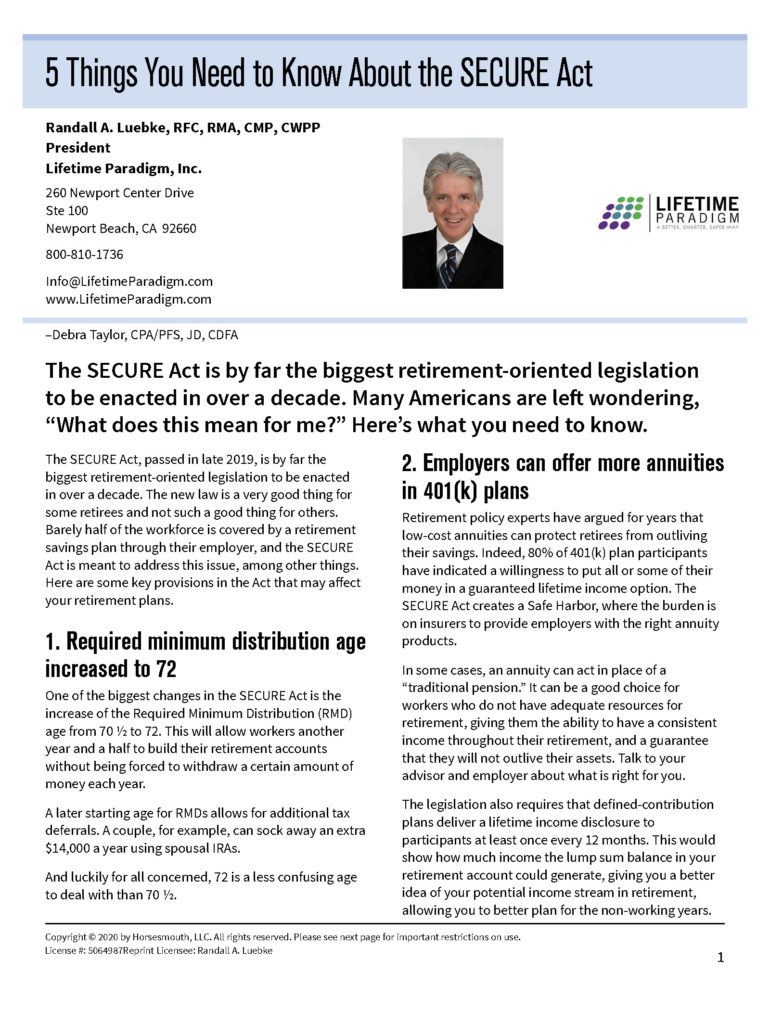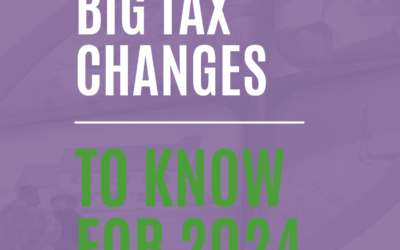5 Things You Need To Know About The SECURE Act
The SECURE Act is by far the biggest retirement-oriented legislation to be enacted in over a decade. Many Americans are left wondering, “What does this mean for me?” Here’s what you need to know.
The SECURE Act, passed in late 2019, is by far the biggest retirement-oriented legislation to be enacted in over a decade. The new law is a very good thing for some retirees and not such a good thing for others. Barely half of the workforce is covered by a retirement savings plan through their employer, and the SECURE Act is meant to address this issue, among other things. Here are some key provisions in the Act that may affect your retirement plans.
1. Required Minimum Distribution Age Increased to 72
One of the biggest changes in the SECURE Act is the increase of the Required Minimum Distribution (RMD) age from 70 ½ to 72. This will allow workers another year and a half to build their retirement accounts without being forced to withdraw a certain amount of money each year.
A later starting age for RMDs allows for additional tax deferrals. A couple, for example, can sock away an extra $14,000 a year using spousal IRAs.
And luckily for all concerned, 72 is a less confusing age to deal with than 70 ½.
2. Employers Can Offer More Annuities in 401(k) Plans
Retirement policy experts have argued for years that low-cost annuities can protect retirees from outliving their savings. Indeed, 80% of 401(k) plan participants have indicated a willingness to put all or some of their money in a guaranteed lifetime income option. The SECURE Act creates a Safe Harbor, where the burden is on insurers to provide employers with the right annuity products.
In some cases, an annuity can act in place of a “traditional pension.” It can be a good choice for workers who do not have adequate resources for retirement, giving them the ability to have a consistent income throughout their retirement, and a guarantee that they will not outlive their assets. Talk to your advisor and employer about what is right for you.
The legislation also requires that defined-contribution plans deliver a lifetime income disclosure to participants at least once every 12 months. This would show how much income the lump sum balance in your retirement account could generate, giving you a better idea of your potential income stream in retirement, allowing you to better plan for the non-working years.
3. Small Businesses and Multiple-Employer Plans
The SECURE Act allows companies to create open multiple-employer plans (MEPs) where different types of employers can pool together to collectively offer a retirement plan to their employees. This reduces costs and administrative duties each employer would otherwise bear alone. Also, there is a tax credit of $500 for small businesses who start a retirement plan.
Not only is this a win for small employers, but also a huge benefit to people who work for them.
Additionally, the SECURE Act expands benefits to long-term part-time workers. Previous law disproportionately affected women as they tend to carry the burden of child/elder care and work part-time. Now, they can participate in 401(k) plans!
If you own a small business, talk to an advisor about participating in a MEP. If you work for a small business, ask your employer if they plan to make any changes.
4. New Parents and Student Loan Repayment Relief
The SECURE Act allows new parents to withdraw up to $5,000 from their retirement plans to cover expenses related to the birth or adoption of a new child, without the 10% early withdrawal penalty. Taxes will still be due on the withdrawals.
It also allows withdrawals of up to $10,000 per person from 529 education savings plans for repayments on student loans. On top of this, the 529 plans may also cover costs associated with registered apprenticeships and homeschooling. We all know that student debt is skyrocketing, and this relief is much needed.
5. Bye-Bye to Stretch IRAs
The SECURE Act will no longer allow all beneficiaries who inherit an IRA to “stretch out” distributions over the beneficiary’s life. Instead, the inheritor must liquidate the account within 10 years, which decreases the value of the inheritance. There are a few exceptions, however, such as when the beneficiary is the surviving spouse, disabled or chronically ill, not more than 10 years younger than the deceased IRA owner, or a child who hasn’t reached age of maturity.
This curtailment on the stretch IRA shines some light on how important advance tax planning really is. Everyone who has a large IRA and likes their kids needs a plan to address the tax issue. There are other ways to leave behind money and draw down large IRA balances. Your advisor can help with this.
The main takeaways
Sustainability seems to be the focal point in the SECURE Act—more workers will have the ability to save for retirement and not outlive their savings. Equally important, the law will curtail the use of stretch IRAs, calling for advanced tax planning so that your assets are best protected at your death.
Debra Taylor, CPA/PFS, JD, CDFA, writes on tax and retirement planning for Horsesmouth, an independent organization providing unbiased insight into the critical issues facing financial advisors and their clients.

Big Tax Changes to Know for 2024
Financial Guides2024 has brought some big tax changes with it. It’s essential to stay informed about these...
The Smart Tax Planning Newsletter March 2024
Tax PlanningIn This Issue: IRAs for Young Adults Get Up to $32,220 in Sick and Family Leave Tax Credits New Crypto Tax...
2024 Key Planning & Investment Deadlines for Q2
Financial GuidesSpring is coming and to keep you financially organized for Q2, we are providing you with our Spring...






